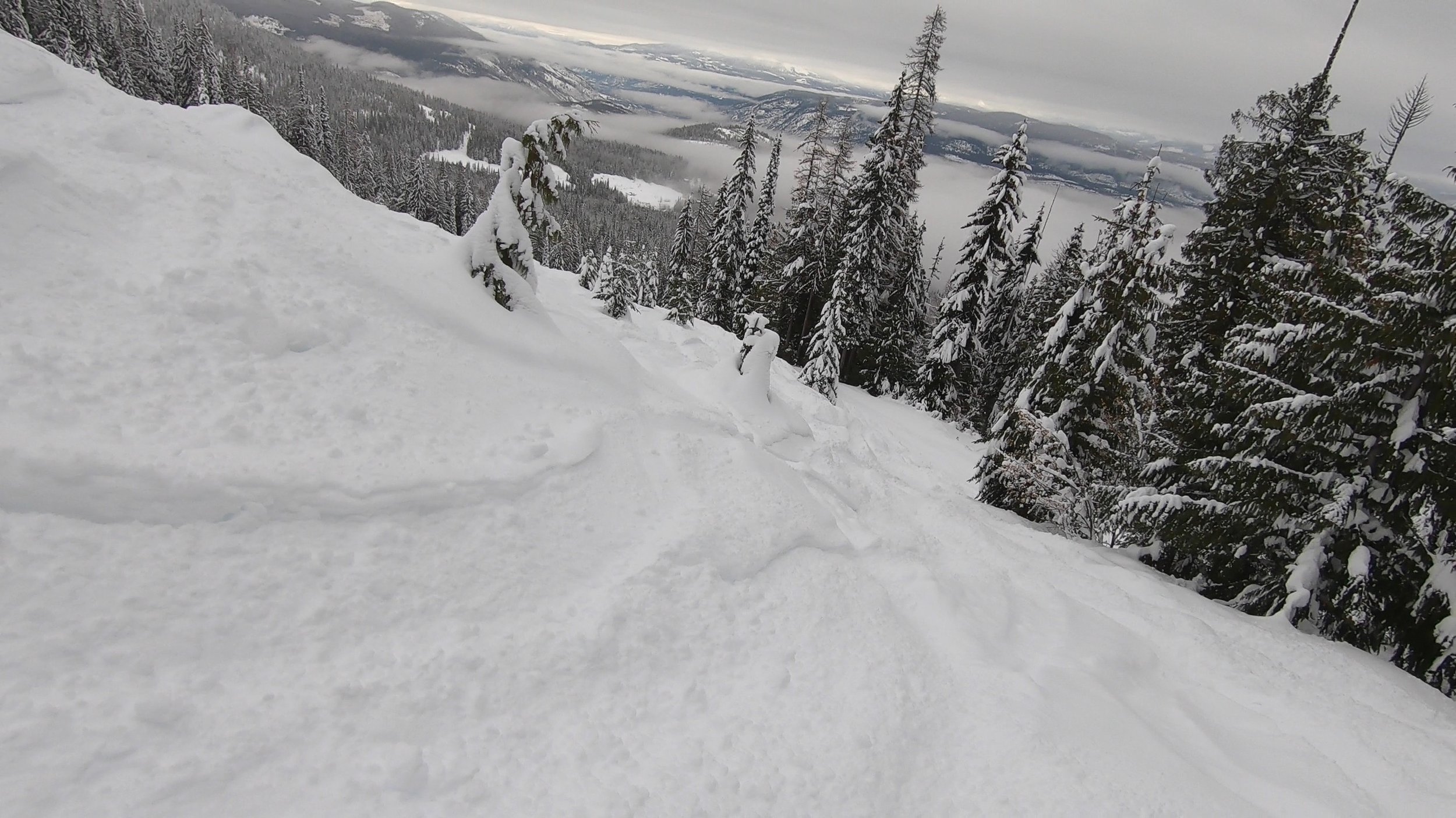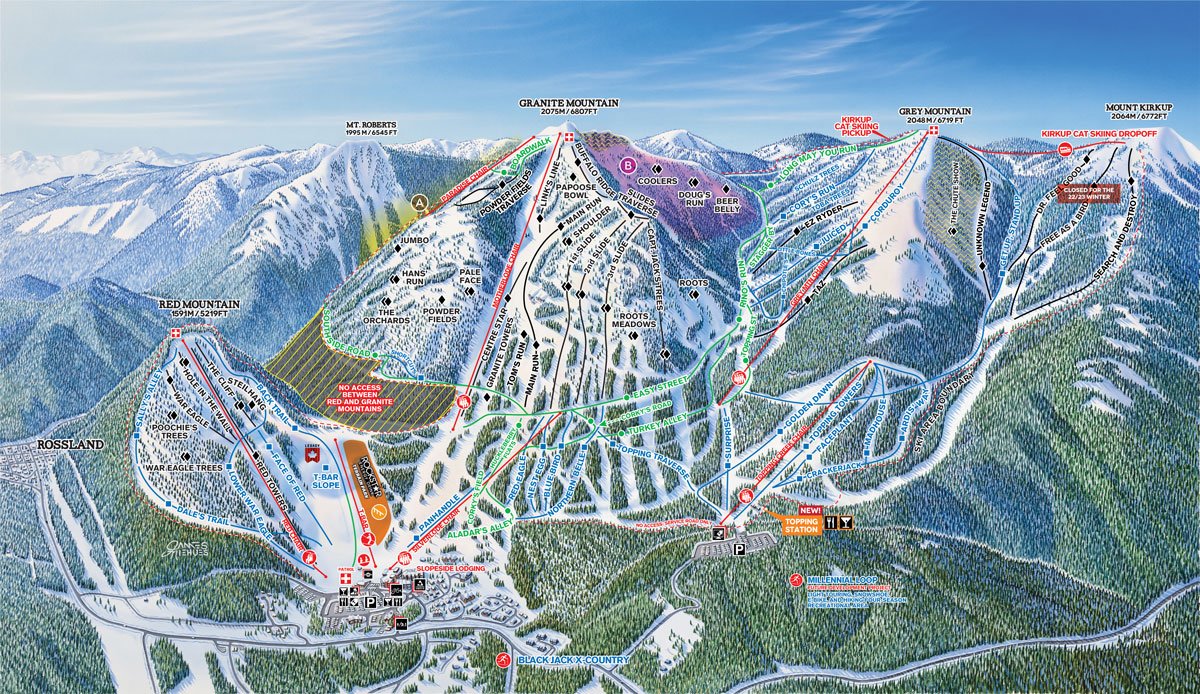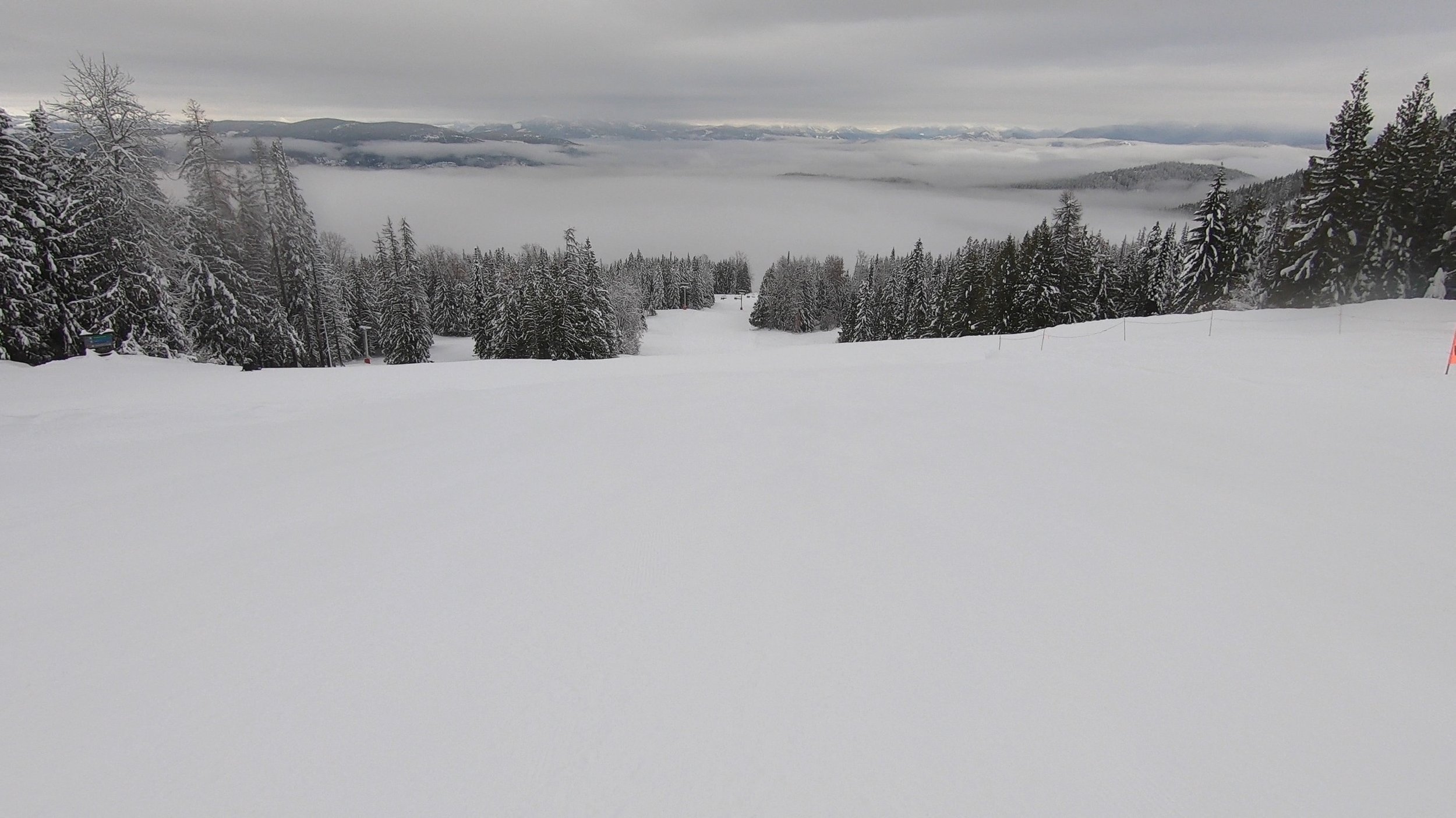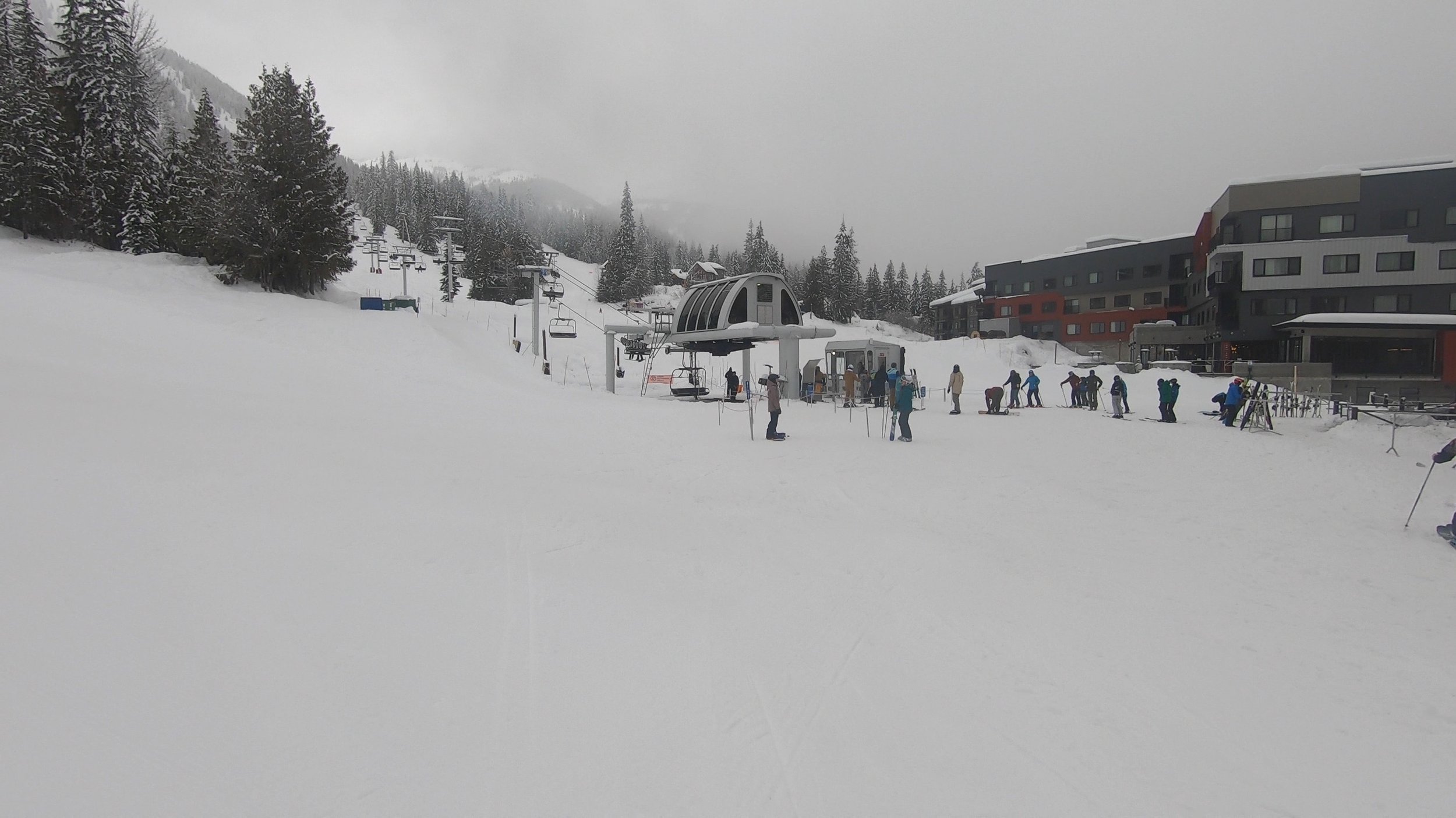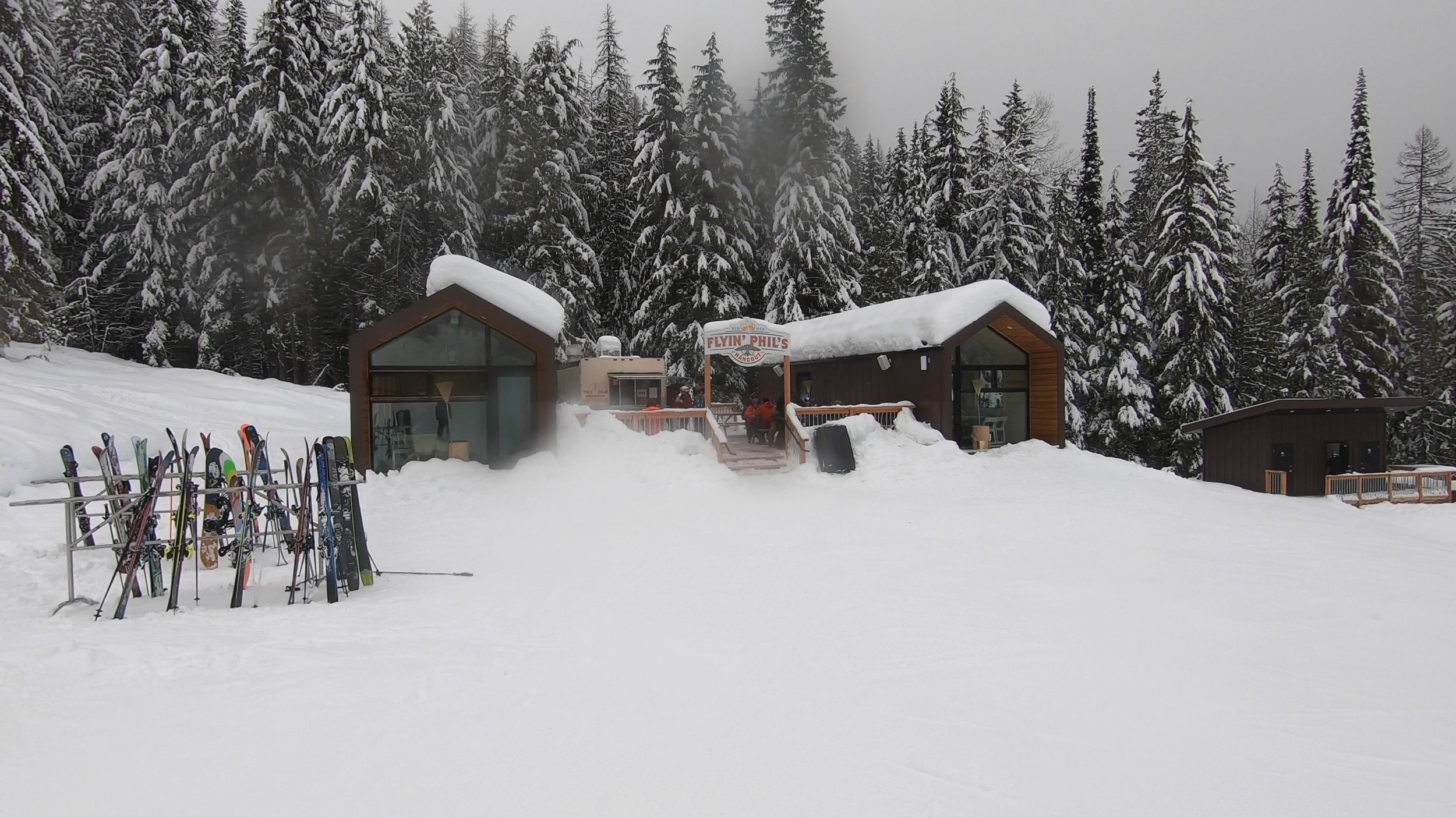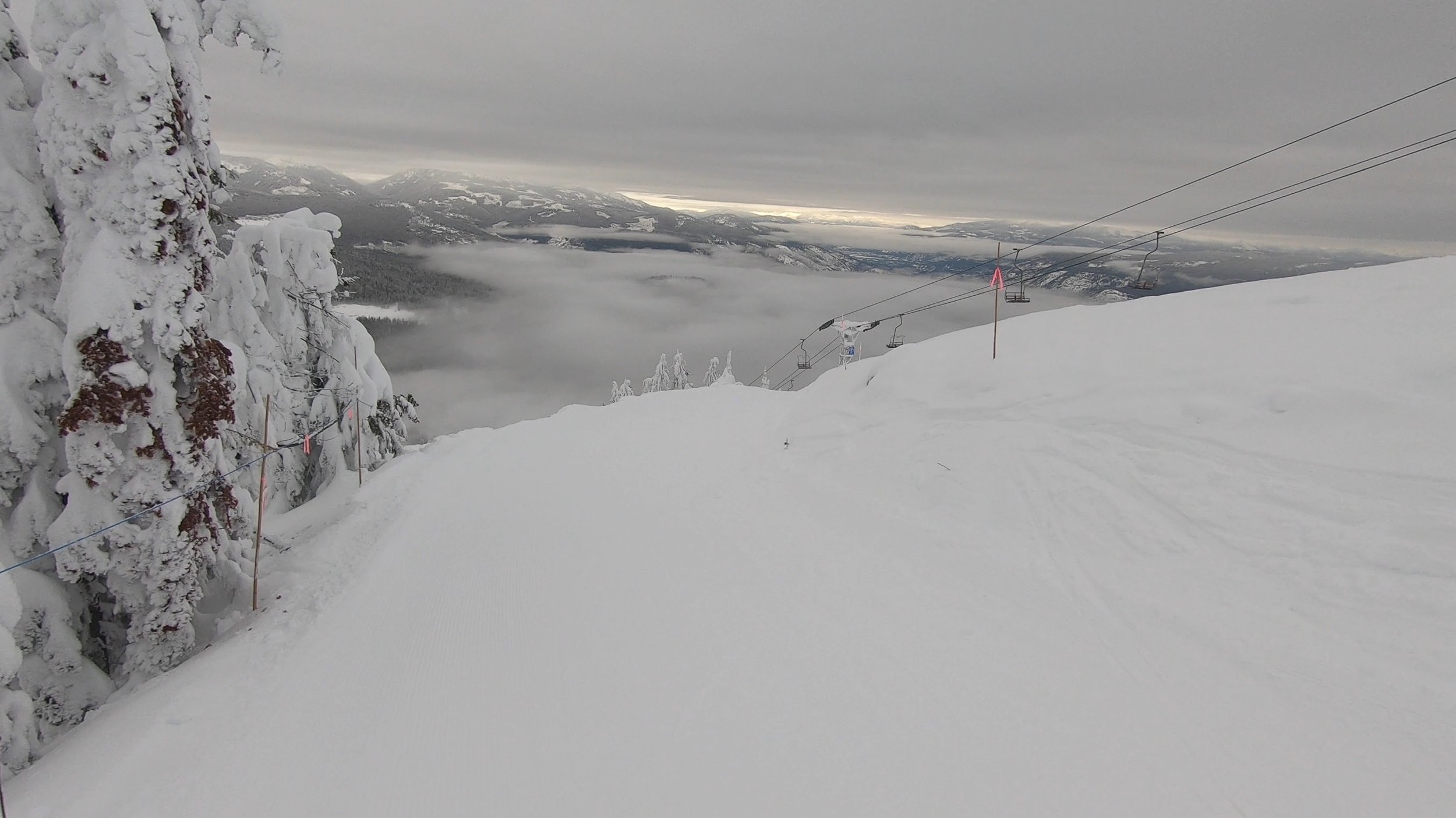Mountain Review: Red Mountain
MOUNTAIN SCORE
CATEGORY BREAKDOWN
See our criteria8
Snow:
7
Resiliency:
8
Size:
6
Terrain Diversity:
9
Challenge:
2
Lifts:
9
Crowd Flow:
4
Facilities:
6
Navigation:
7
Mountain Aesthetic:
GOOD TO KNOW
1-Day Ticket: $85-$106 USD ($115-$144 CAD)
Pass Affiliation: Ikon Pass
On-site Lodging: Yes
Aprés-ski: Limited
Nearest Cities: Spokane (3 hrs), Kelowna (3.5 hrs)
Recommended Ability Level:
+ Pros
Sizable footprint
Extremely demanding off-piste terrain
Lack of crowds
Local feel
– Cons
Slow lifts in every resort area
Lower snowfall totals than some competitors
Limited beginner and low intermediate terrain
MOUNTAIN STATS
Lifts: 8
Trails: 119
Beginner: 17%
Intermediate: 34%
Advanced/Expert: 49%
Mountain Review
Located in the Monashee Mountains just north of the United States border, Red Mountain is one of the oldest ski areas in North America, with a history that dates back more than a hundred years. The resort may have a storied history—and it boasts a sizable footprint—but it’s not exactly well-known outside the local region. While it turns out there are a couple of weighty reasons for Red Mountain’s lack of notability, the resort is still well worth the trip for the right individuals.
Snow Quality and Resiliency
Western Canada is known for its powder, and Red Mountain is no exception. The resort experiences strong preservation thanks to its low visitation density, and trees often catch and hold tons of accumulation. This helps make up for relatively modest snow accumulation compared to better known destinations in Interior British Columbia. Red often sees a solid amount of its accumulation earlier in the season, so it can be a relatively good bet for a late December or early January trip.
However, Red Mountain sits at a somewhat low base elevation as far as Western destinations go. Dry, pristine powder does make its way to Red on good days, but accumulation can be on the heavier side during warmer weather events, especially in lower mountain areas. While rare, the resort can see rain, especially in the earlier weeks of the season leading up to mid-January.
Fortunately, the resort tends to open up its terrain fairly quickly, even in less favorable seasons, making most areas and terrain levels accessible in a reasonable timeframe. That said, guests should anticipate thin cover more akin to some East Coast resorts earlier in the season, especially in below-average snow years.
Red Mountain offers strong early-season snow totals and good preservation, although accumulation can be on the heavier side in lower mountain areas.
Resort Layout
Red Mountain boasts a thorough footprint, although their claim of having five “different” peaks is somewhat misleading. The resort offers lift service on three distinct mountains: Red, Granite, and Grey Mountains, and usually offers cat skiing on a fourth—Mt. Kirkup—although this service was not offered for the 2022-23 season, and the status is unclear for 2023-24. The fifth peak—Mt. Roberts—is visible from the resort but doesn’t play a practical role in offering skiable terrain; however, this peak is popular for backcountry touring.
Red Mountain is made up of three lift-served peaks and one additional snowcat-accessed mountain.
Red Mountain feels wider than it is tall, and while its 2,900-foot vertical drop is respectable, it’s not class-leading among British Columbia mountains. The resort sits entirely below treeline, although a small amount of open, bowl-like terrain does exist. Red Mountain especially excels in its tree terrain, featuring extensive skiable woods across every resort area. The resort’s topography isn’t the most striking out there, but Red’s remote atmosphere makes for a distinctive isolated vibe that’s hard to replicate at more commercialized competitors.
TRAIL MAP
Beginner Slopes
Red Mountain is not exactly ideal for beginners. The mountain may have a couple of top-to-bottom green trails, but options across the protrusive footprint are generally limited. Less experienced guests should stick to the Silverlode and Paradise chairs; the Grey chair does serve one green trail, but it acts as a “filter” run for more difficult trails along the mountain and therefore sees more aggressive skier and rider traffic.
Red Mountain’s beginner and low intermediate terrain is somewhat limited, but the resort employs strong upkeep on the trails that do see grooming.
Intermediate Slopes
Not every terrain zone at Red Mountain is great for intermediates, but there are some pretty solid areas for this ability level. The entire lower mountain consists of ample modestly-sloped cruiser terrain, while the upper-mountain boasts interesting glades. However, these runs are on the tougher side as far as intermediate-rated trails go, especially in the upper mountain, and not all of them receive grooming, resulting in challenges that are more akin to black-rated trails at some other resorts. At the same time, several blue runs do regularly receive grooming, and the upkeep on these trails is pretty good.
Red is home to some of the gnarliest tree terrain out there, with daunting pitches and obstacles within.
Advanced and Expert Terrain
Red is really an expert’s mountain, and prospective visitors should try to be of at least advanced proficiency before booking a destination trip here. Nearly half of the resort comprises advanced and expert terrain, and upper-mountain resort areas boast scores of steep, demanding mogul runs. Those who want to dip their foot in Red’s challenges for the first time should go with the single-black runs off the Paradise and Grey chairs, which offer escapes to easier terrain levels in the event they’re too difficult.
But guests will want to get comfortable on Red’s single-blacks quickly, as its most interesting terrain lives in expert-only, double-black resort zones. Red’s expert terrain is entirely natural—none of it exists on man-made, tree-cut trails—and it’s some of the toughest out there, with insanely tight trees, extensive obstacles such as rocks and tree stumps, and profound fall lines. Red’s most extreme terrain exists in its “cliff areas”; these zones are subject to variable opening schedules, and as their name might suggest, they often require mandatory straightlining or cliff drops to complete.
RECOMMENDED SKIS FOR RED MOUNTAIN
NOTE: We may receive a small affiliate commission if you click on the below links. All products listed below are unisex.
Recommended intermediate ski
Recommended advanced ski
Recommended glade ski
Recommended powder ski
Lifts
You go to Red Mountain for its terrain, not because of its on-mountain infrastructure. All of Red’s lifts are slow, making it the largest mountain we’ve ever visited without a single high-speed chairlift. At least two of these chairs involve longer than ten-minute ride times, and on cold days, they can really wear down on you. It takes at least two chairlifts to get to the tops of Granite and Grey Mountains, so if you’re trying to start your day at either one of them, it can take 15 to 20 minutes to get from the parking lot to your first lap. Annoyingly, if you’re starting from the main base area, it takes at least three lift rides to get to the top of Grey Mountain; while the out-of-base Silverlode chair ends near the bottom of the Grey Mountain chair, it’s just slightly too short to allow for access, meaning guests will have to also withstand an out-of-the way lift ride up the Motherlode or Topping Creek chairs.
Every chairlift at Red Mountain is slow, making for some lengthy ride times.
Crowds
Luckily, guests will never be waiting too long to ski or ride because Red rarely sees any sort of notable lift lines. The resort is essentially empty on all but the busiest holidays, and you can pretty much ski on to any lift after 10am. There may be a so-called initial morning “rush” from the main parking lot, but this really only involves a 1-2 minute wait at the Silverlode chair. On peak weekends and holidays, guests can quickly get back the intervals spent riding up lifts in saved lift line time.
Guests will rarely, if ever, wait in lift lines at Red Mountain.
Navigation Logistics
Red Mountain’s layout makes for some minor confusions. Some of the trails directly below the Motherlode trail are unmarked and seemingly unmaintained, leaving it unclear what purpose they are there for. These trails do require a very mild uphill section to reach, but once on them, it becomes apparent that they are actually snowmobile trails. Unfortunately, if you end up at the bottom of the Motherlode trail and miss the cutoff for the Southside Road trail, you have to take one of these “runs” to get back to the base.
The tree-cut area directly below the Motherlode chair, pictured in the distance, could easily be mistaken for a ski run. However, it’s actually a snowmobile trail.
It’s also worth noting that the resort’s namesake Red Mountain is much smaller and completely separate from the rest of the resort. The Red Mountain terrain area, which is the resort’s longest-operating skiable zone, serves a mix of intermediate to expert trails across a 1,400-foot vertical drop. While less extensive than the resort’s Granite and Grey Mountain terrain, the terrain on Red Mountain proper is logistically straightforward to access and often less tracked than the rest of the ski area.
RECOMMENDED SNOWBOARDS FOR RED MOUNTAIN
NOTE: We may receive a small affiliate commission if you click on the below links. All products listed below are unisex.
Recommended intermediate board
Recommended advanced board
Recommended expert board
Recommended powder board
Temperature and On-Mountain Facilities
Red Mountain offers fairly inoffensive temperatures compared to some other Interior British Columbia resorts. However, the resort does get quite frigid at times, and during a typical season, temperatures may occasionally drop below 0°F (-18°C). If you’re looking to escape the cold—which can be especially brutal given Red’s antiquated lift fleet—the resort does offer a handful of lodges to stop in for a break. In addition to cafeteria and restaurant service at the main base, guests can stop at the Paradise Lodge near the top of Granite Mountain and the brand-new Topping Station just above the base of the Topping Creek chair. These facilities aren’t the fanciest or largest out there, but for the resort’s visitation, they get the job done.
Night Skiing
Red Mountain offers night skiing on a limited selection of its lower-mountain terrain on select Thursdays from 6pm to 9pm, including beginner, intermediate, and freestyle trails served by its t-bar and magic carpet. Some might enjoy the post-sundown skiing and riding, but it really only covers one trail and is not continuously offered after daytime operations (the resort shutters for a few hours in between day and night sessions).
Red Mountain’s on-mountain lodges aren’t the fanciest, but they’re sufficient for the resort’s clientele.
Pass Affiliations
Red Mountain is a partner on the Ikon Pass, and the resort comes with five to seven days of access with or without holiday blackouts, depending on the pass tier. Guests can also access Red via the Ikon Session Pass, which comes with two-to-four days of cumulative access at 40 different destinations.
Getting There
Red Mountain may be remote, but it’s within a few hours’ drive of several regional international airports. Those coming from the United States will want to fly through Spokane, Washington, which is just under three hours away with no traffic and reasonable border waits. Most guests coming from within Canada will want to fly through Kelowna, which is about three-and-a-half hours from the resort. Those hoping to avoid driving can book a shuttle service from either airport.
Red Mountain sits in a very remote location, and it’s about three hours from the closest major airport.
Lodging and Parking
Red Mountain offers ample accommodations both onsite and in the nearby town of Rossland. Options onsite include two hotels: the unassuming HI RED Mountain hostel and the four-star, ski-in/ski-out Josie Hotel, and a number of vacation home rentals. Rossland is only a five-minute drive away, with a number of reasonably-priced inns and condos.
Red offers complimentary onsite parking for all guests. Those with RVs can park at the resort free of charge for up to seven days.
Aprés-ski
Red Mountain is much more of a place to knock back a few brews with the locals than a true party mountain. The resort has a handful of bars onsite with solid happy hour vibes. While nightlife is limited, visitors may want to check out downtown Rossland, where pubs and bars offer lively, local-heavy vibes on Fridays and Saturdays.
Several on-site condos and hotels offer convenient access to Red’s slopes.
Verdict
Red Mountain lacks many of the creature comforts that travelers may have come to expect from typical destination ski resorts, and its elevation means conditions can be hit or miss. But if you have a strong aversion to crowds or want to check out some of the gnarliest in-bounds tree skiing on the continent, Red will not let you down.
Pricing
Red Mountain’s lift tickets are fairly reasonable, topping out at just $144 CAD, but they’re not that much cheaper than other, more well-rounded resorts in the province.








